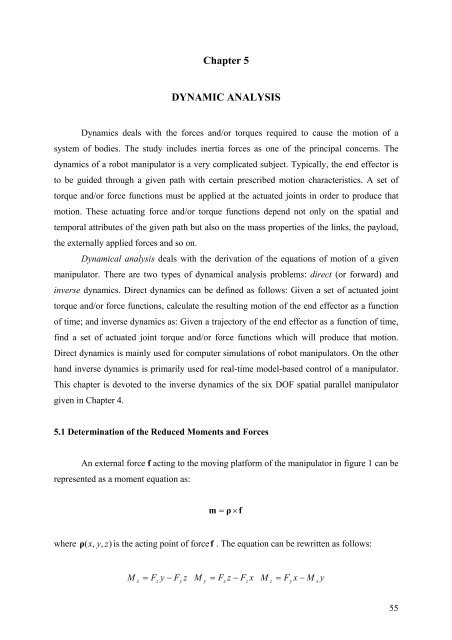Kinematic and Dynamic Analysis of Spatial Six Degree of Freedom ...
Kinematic and Dynamic Analysis of Spatial Six Degree of Freedom ...
Kinematic and Dynamic Analysis of Spatial Six Degree of Freedom ...
You also want an ePaper? Increase the reach of your titles
YUMPU automatically turns print PDFs into web optimized ePapers that Google loves.
Chapter 5<br />
DYNAMIC ANALYSIS<br />
<strong>Dynamic</strong>s deals with the forces <strong>and</strong>/or torques required to cause the motion <strong>of</strong> a<br />
system <strong>of</strong> bodies. The study includes inertia forces as one <strong>of</strong> the principal concerns. The<br />
dynamics <strong>of</strong> a robot manipulator is a very complicated subject. Typically, the end effector is<br />
to be guided through a given path with certain prescribed motion characteristics. A set <strong>of</strong><br />
torque <strong>and</strong>/or force functions must be applied at the actuated joints in order to produce that<br />
motion. These actuating force <strong>and</strong>/or torque functions depend not only on the spatial <strong>and</strong><br />
temporal attributes <strong>of</strong> the given path but also on the mass properties <strong>of</strong> the links, the payload,<br />
the externally applied forces <strong>and</strong> so on.<br />
<strong>Dynamic</strong>al analysis deals with the derivation <strong>of</strong> the equations <strong>of</strong> motion <strong>of</strong> a given<br />
manipulator. There are two types <strong>of</strong> dynamical analysis problems: direct (or forward) <strong>and</strong><br />
inverse dynamics. Direct dynamics can be defined as follows: Given a set <strong>of</strong> actuated joint<br />
torque <strong>and</strong>/or force functions, calculate the resulting motion <strong>of</strong> the end effector as a function<br />
<strong>of</strong> time; <strong>and</strong> inverse dynamics as: Given a trajectory <strong>of</strong> the end effector as a function <strong>of</strong> time,<br />
find a set <strong>of</strong> actuated joint torque <strong>and</strong>/or force functions which will produce that motion.<br />
Direct dynamics is mainly used for computer simulations <strong>of</strong> robot manipulators. On the other<br />
h<strong>and</strong> inverse dynamics is primarily used for real-time model-based control <strong>of</strong> a manipulator.<br />
This chapter is devoted to the inverse dynamics <strong>of</strong> the six DOF spatial parallel manipulator<br />
given in Chapter 4.<br />
5.1 Determination <strong>of</strong> the Reduced Moments <strong>and</strong> Forces<br />
An external force f acting to the moving platform <strong>of</strong> the manipulator in figure 1 can be<br />
represented as a moment equation as:<br />
m = ρ × f<br />
where ρ( x,<br />
y,<br />
z)<br />
is the acting point <strong>of</strong> forcef . The equation can be rewritten as follows:<br />
M x =<br />
Fz<br />
y − Fy<br />
z M y = Fx<br />
z − Fz<br />
x M z = Fy<br />
x − M x y<br />
55
















